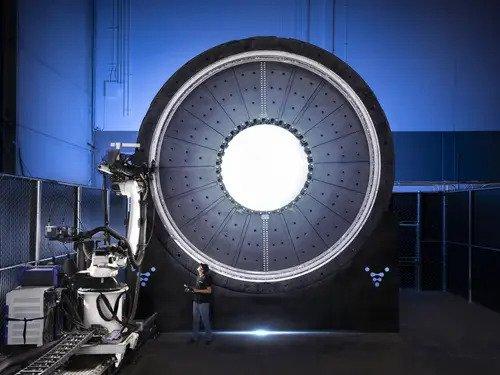Relativity Space is gearing up for the launch of the world’s first 3D-printed rocket. The Terran 1 rocket is slated to take off from Cape Canaveral imminently and, should it succeed, will become the largest 3D-printed item to achieve orbital flight.
The mastermind behind this 3D-printed rocket is Tim Ellis, who used to work at Jeff Bezos’ space venture, Blue Origin. Terran 1 represents Relativity Space’s initial functional rocket prototype, and as the world’s first 3D-printed rocket, it is a milestone achievement.
The rocket has already passed its wet dress rehearsal successfully, and Relativity Space is now poised to conduct its maiden test flight. If the launch proves successful, Terran 1 will be the first rocket, made up of nearly exclusively 3D-printed parts, to reach orbit.
Approximately 85% of the rocket was printed with colossal 3D metal printers. The rocket weighs 20,500 pounds and stands at a height of 110 feet with a width of 7.5 feet. Nine engines will be used to launch the rocket off the ground, and it can transport a payload of approximately 2,800 pounds to a low earth orbit.
“The team went HARD today and we intend to do so during our next attempt. More to come on the new launch date and window soon,” Relativity Space said in a tweet Saturday.
Although there have been some unsuccessful launch attempts, the firm’s Twitter account says a new launch date will be announced shortly.
In order to print such a big object, the first step for Relativity Space was to design 3D metal printers that could build a whole section of a rocket.
The printers, called Stargate, need to print the rocket in about 1,000 pieces. That means that the biggest pieces they’re printing are about 20 feet tall, said Ellis.
“The largest printers that existed when we started the company could only do about a single cubic foot,” said Ellis. “What Relativity had to do was invent the world’s largest metal 3D printers.”
The pieces are then joined up by a machine “that’s very similar to a 3D printer but it ends up, joining those pieces together again without fixed tooling,” said Ellis.
While Relativity’s Terran 1 rocket is a significant achievement, it pales in comparison to SpaceX’s Starship, which can carry 150 metric tons to orbit and be reused.
However, for Tim Ellis, Terran 1 is merely a stepping stone toward his ultimate goal of constructing a much larger and entirely reusable rocket called Terran R. This 3D-printed rocket is designed to transport 20,000 kilograms of payload, matching SpaceX’s Falcon 9, and will be almost entirely 3D-printed, with a target of at least 95%.

Relativity plans to launch Terran R in 2024, and Ellis envisions it being used for missions to Mars. Despite still being under development, Ellis is optimistic that the rocket will come together quickly, with the AEON R engine that will power the second stage of the rocket already having been tested.
“That was a blank sheet of paper about a year and a half ago,” he said. “So to go from a blank sheet to build the first full of the engine, which we just completed, and then already doing engine component testing at full scale is quite incredibly fast,” he said.
If it succeeds, Ellis will beat Elon Musk’s SpaceX to the red planet, and the mission would be the first-ever commercial mission to go to Mars.


